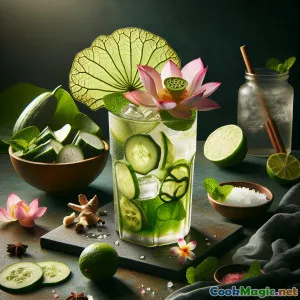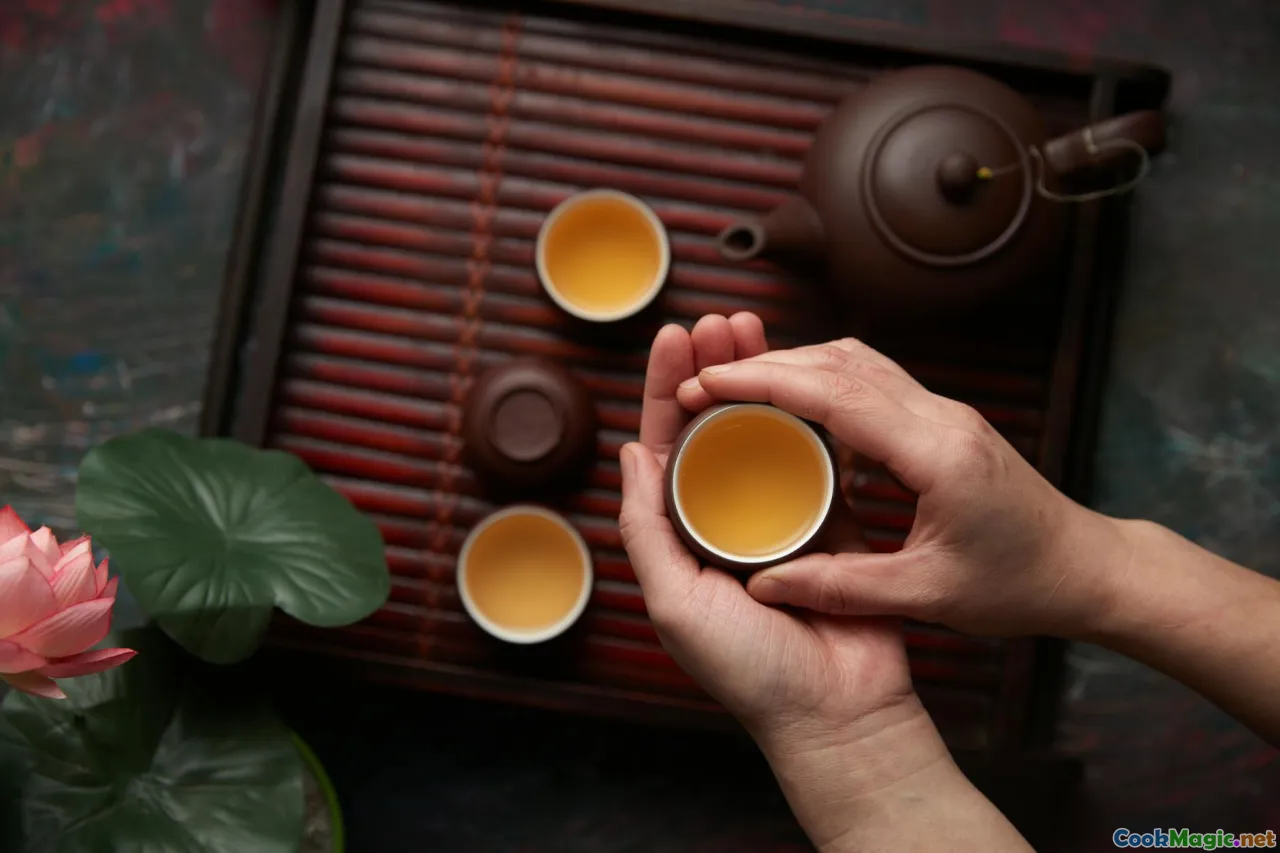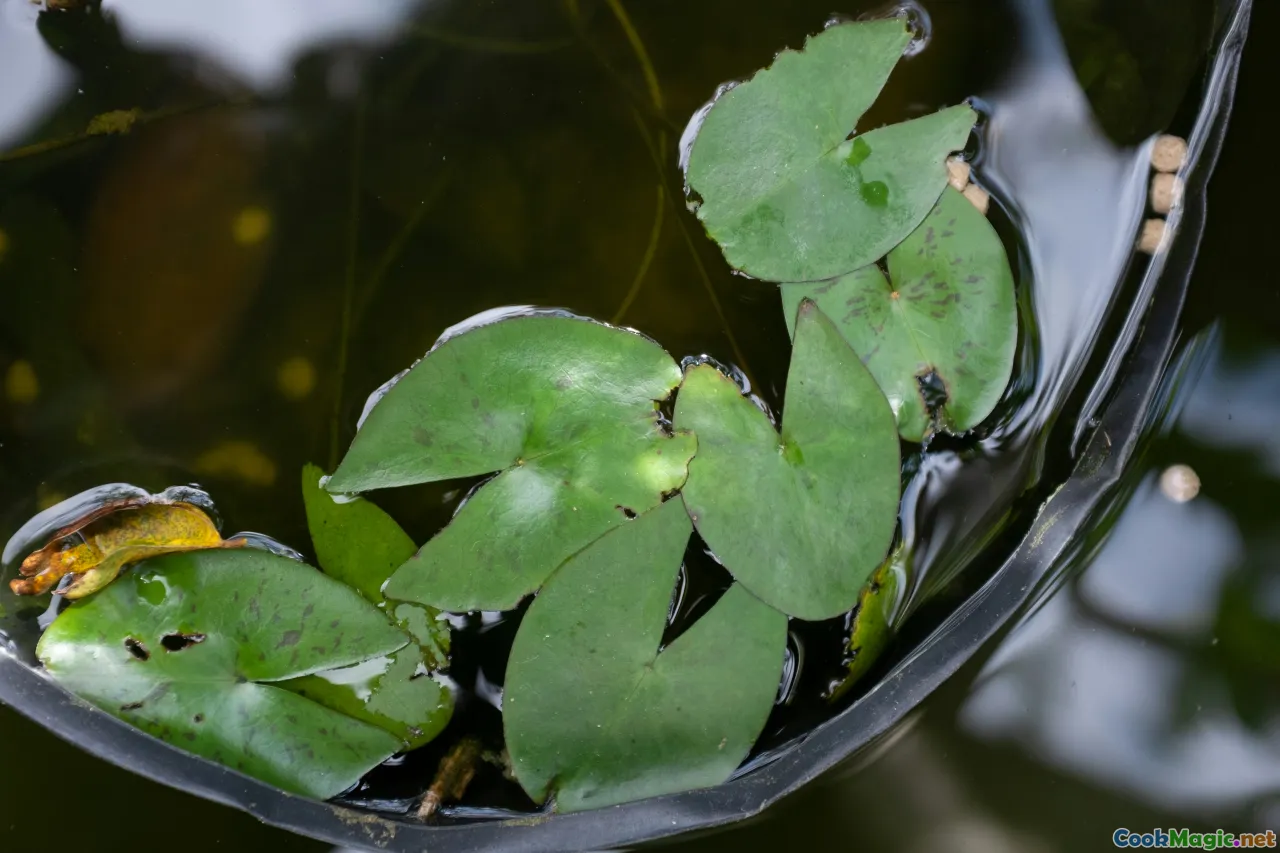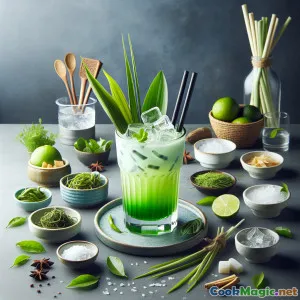
Đồ uống mát lạnh Lá sen Xanh Mướt với dưa chuột và hoa nhài
(Lotus Leaf Lush Cucumber-Jasmine Cooler)
(0 Đánh giá)0
137
tháng 10 20, 2025
Báo cáo sự cố
Nguyên liệu
-
2 grams Lá sen khô (an toàn thực phẩm)
(Rinse briefly to remove dust)
-
2 tsp Trà xanh hoa nhài
(Loose leaf or 1 tea bag)
-
250 ml Nước lọc
(Hot, about 80°C for steeping)
-
200 ml Nước Dừa
(Lạnh)
-
30 ml Nước chanh tươi
(Khoảng 1 quả chanh lục trung bình)
-
20 ml Sirup lá dứa
(Sub with simple syrup or honey)
-
6 slices Dưa leo
(Thêm nhiều để trang trí)
-
100 ml Nước Soda
(To top, well-chilled)
-
1 cup Viên đá
(Clear ice preferred)
-
1 pinch Muối biển
(Balances bitterness)
-
6 leaves Lá bạc hà tươi
(Trang trí và tạo hương thơm)
-
2 slices Gừng tươi
(Adds gentle warmth)
-
1 piece Hoa ăn được
(Lotus petal or marigold for garnish)
(Rinse briefly to remove dust)
(Loose leaf or 1 tea bag)
(Hot, about 80°C for steeping)
(Lạnh)
(Khoảng 1 quả chanh lục trung bình)
(Sub with simple syrup or honey)
(Thêm nhiều để trang trí)
(To top, well-chilled)
(Clear ice preferred)
(Balances bitterness)
(Trang trí và tạo hương thơm)
(Adds gentle warmth)
(Lotus petal or marigold for garnish)
Dinh dưỡng
- Khẩu phần: 2
- Kích thước khẩu phần: một ly cao (300 ml)
- Calories: 110 kcal
- Carbohydrates: 0 g
- Protein: 1 g
- Fat: 0 g
- Fiber: 0.5 g
- Sugar: 22 g
- Sodium: 65 mg
- Cholesterol: 0 mg
- Calcium: 40 mg
- Iron: 0.5 mg
Hướng dẫn
-
1 - Rinse and prepare botanicals:
Briefly rinse the dried lotus leaf under cool water to remove dust. Lightly crumble it to expose more surface area. Measure out jasmine tea.
-
2 - Steep the infusion:
Add lotus leaf and jasmine tea to a heatproof vessel. Pour over 250 ml hot water (about 80°C). Steep 5–6 minutes to avoid bitterness.
-
3 - Strain and Cool:
Strain the infusion into a shaker tin or jug. Add a few ice cubes to bring the temperature down quickly, then discard the melted ice.
-
4 - Muddle base flavors:
In the shaker, gently muddle cucumber slices with pandan syrup and a pinch of sea salt. Add lime juice, coconut water, and optional ginger.
-
5 - Shake and build:
Fill the shaker with fresh ice and the cooled lotus-jasmine infusion. Shake briefly (8–10 seconds) to chill and integrate without over-dilution.
-
6 - Strain, top, and garnish:
Fine-strain into two tall ice-filled glasses. Top each with soda water. Garnish with mint, extra cucumber, and an edible flower. Serve immediately.
Briefly rinse the dried lotus leaf under cool water to remove dust. Lightly crumble it to expose more surface area. Measure out jasmine tea.
Add lotus leaf and jasmine tea to a heatproof vessel. Pour over 250 ml hot water (about 80°C). Steep 5–6 minutes to avoid bitterness.
Strain the infusion into a shaker tin or jug. Add a few ice cubes to bring the temperature down quickly, then discard the melted ice.
In the shaker, gently muddle cucumber slices with pandan syrup and a pinch of sea salt. Add lime juice, coconut water, and optional ginger.
Fill the shaker with fresh ice and the cooled lotus-jasmine infusion. Shake briefly (8–10 seconds) to chill and integrate without over-dilution.
Fine-strain into two tall ice-filled glasses. Top each with soda water. Garnish with mint, extra cucumber, and an edible flower. Serve immediately.
Thông tin thêm về: Đồ uống mát lạnh Lá sen Xanh Mướt với dưa chuột và hoa nhài
Lotus Leaf Lush: A Serene, Sparkling Garden in a Glass
Lotus Leaf Lush is a tranquil, fragrant mocktail that borrows time-honored tea traditions from Viet Nam and dresses them in contemporary bar technique. At its heart is a gentle infusion of lotus leaf and jasmine tea—two botanicals celebrated across Southeast Asia for their calming aromas and nuanced, slightly green flavors. Balanced with cool cucumber, bright lime, a whisper of pandan sweetness, and an effervescent cap of soda water, this drink channels the freshness of a riverside garden at dusk.
Flavor Profile
Expect a feather-light bitterness from lotus leaf, tempered by jasmine’s floral top notes. Coconut water contributes soft sweetness and a minerally finish, while pandan syrup lays down vanilla-like, grassy warmth. Lime adds a crystalline brightness that keeps the palate lively. Cucumber introduces a juicy, dewy coolness; soda water gives a delicate lift. The overall impression is refreshing yet contemplative—herbal, floral, and verdant without being sugary or heavy.
Technique Notes
- Steeping: Lotus leaf is delicate. Steep around 80°C for 5–6 minutes to extract aroma without drawing out harsh tannins. Oversteeping or using boiling water can make the cup astringent.
- Quick chill: Cooling the infusion with a few ice cubes in the shaker prevents wilted aromatics and preserves that fresh-tea perfume. Discard the early melted ice to control dilution.
- Muddling: Gently muddle cucumber; you want juice and aroma, not bitterness from crushed peels. A pinch of sea salt acts as a flavor amplifier, rounding edges and brightening the floral notes.
- Carbonation: Top with chilled soda water rather than shaking it in; this keeps the bubbles lively and the texture elegant.
Sourcing and Substitutions
- Lotus leaf: Look for food-grade dried lotus leaf at Vietnamese or broader Asian markets, herbal shops, or online. If unavailable, try a blend of green tea with a small piece of hojicha or a mild herb like lemon balm; the character shifts, but the drink remains balanced.
- Pandan syrup: Make your own by simmering pandan leaves with equal parts sugar and water, then straining. In a pinch, use simple syrup with a drop of vanilla or a few grains of toasted rice for a nuanced aroma.
- Coconut water: Choose unsweetened varieties for control over sugar. Plain water works, but you’ll lose some roundness.
- Jasmine tea: A tea bag substitutes fine; reduce steep time by a minute to avoid perfume overload.
Cultural Context
In Vietnamese cuisine, the lotus plant is a symbol of purity and resilience, rising clean from the mud to bloom radiant. Lotus leaves have long served culinary and ceremonial roles—wrapping sticky rice, scenting teas, and imparting a calm, faintly bitter complexity. Jasmine tea, also popular in Viet Nam, China, and beyond, represents hospitality and refinement. Uniting these ingredients in a modern, non-alcoholic drink pays homage to those traditions while embracing the global movement toward sophisticated zero-proof options.
Serving and Pairing
Serve Lotus Leaf Lush in a tall, clear glass to showcase its pale green hue and delicate garnish. It pairs gracefully with light, aromatic fare: rice paper rolls, chilled vermicelli salads, steamed fish with ginger, or tropical fruit platters. For gatherings, the infusion can be doubled or tripled, then shaken to order with fresh ice and garnishes.
Make-Ahead and Storage
- Infusion: Brew the lotus-jasmine base up to 24 hours in advance; store chilled in a sealed container. Flavors soften slightly overnight, which can be pleasant.
- Syrup: Pandan syrup keeps 2–3 weeks refrigerated.
- Carbonation: Always add soda at the last moment for maximum sparkle.
Variations
- Sparkling Sencha Swap: Replace jasmine with sencha; increase pandan syrup by 5 ml if the tea leans grassy.
- Citrus Fan: Add yuzu or pomelo zest to the shaker for layered aromatics.
- Peppery Lift: Crack two turns of white pepper over the finished drink for a surprising floral-pepper nose.
- Cocktail Option: For a spirited version, a light, floral gin (15–20 ml per serving) or rice-based shochu integrates beautifully. Keep sweetness in check to preserve the lotus character.
Tips for Success
- Taste as you go; adjust lime and syrup in 2–3 ml increments.
- Use large, clear ice cubes to reduce dilution and maintain clarity.
- Fine-strain to remove cucumber seeds or lotus flecks for a polished texture.
Lotus Leaf Lush is more than a refresher; it is a quiet pause in a glass. Each sip carries the whisper of lotus ponds and late-afternoon breezes, marrying tradition with modern craft for a drink that feels both rooted and new.






















